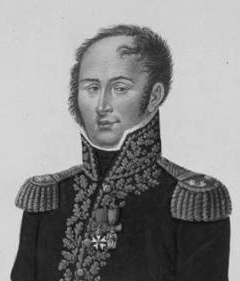General Jean Mathieu Séras

Born: April 16, 1765
Place of Birth: Osasio, Italy
Died: April 14, 1815
Place of Death: La Tronche, France
Arc de Triomphe: SERAS on the south pillar
Pronunciation:
Born in Piedmont, Jean Mathieu Séras entered the service of France in August of 1791 as a sous-lieutenant. In August of 1792 he was promoted to capitaine of carabiniers in the Legion of Allobroges and that year he served with the Army of the Alps. Séras next served at the affair of Petit-Saint-Bernard where he was wounded. In 1793 he was promoted to chef de bataillon and he served at the Siege of Toulon in December where he was wounded by four shots at the action of the redoubt named Petit Gibraltar. In January of 1794 Séras was sent to the Army of the Eastern Pyrenees to serve under General Augereau. That May he was wounded in the heel at the action of the foundry of Saint-Laurent de la Mouga and then in June he was wounded in the left shoulder at Ripoll. Towards the end of 1795 Séras was sent to the Army of Italy where he continued to serve under Augereau. In April of 1796 he was wounded by a shot to the leg in the attack of Ceva. Séras remained in Italy and in 1798 he was promoted to chef de brigade by General Joubert. In 1799 he became chief of staff to Grouchy's division and that June he served at the combat of San Giuliano. In August Séras was promoted to général de brigade by General Championnet and then in November he joined Lemoine's division. In March of 1800 Séras was employed in Clauzel's division. April of 1800 became a busy month for Séras as he first repulsed the Austrians at the combat of Melogno and then seized the redoubts of Murialto and served at Monte San Giacomo.
In 1801 Séras returned home and then he was employed in the 7th military division. In 1802 he served with the Army of Switzerland under General Ney and in 1803 he was sent to the camp of Bruges where he commanded a brigade under Davout. Séras was promoted to général de division in February of 1805 and when war broke out he was sent back to the Army of Italy to command the 5th Division under Marshal Masséna. In October he crossed the Adige at Ponto Polo and then in November he occupied Bassano and Trieste. In February of 1806 Séras was sent to command the division occupying Istria and later he served in the Frioul. He was later named a Knight of the Iron Crown.
When the Austrians declared war on France and her allies in 1809, General Séras took command of the 1st Division of the Army of Italy. That April he served on the right at the Battle of Sacile and then he was wounded at the combat of Soave at the end of the month. In May Séras seized Vicenza, took the fort of Pradel, and served at San Michele. Next he took Leoben and Bruck and then fought at the Battle of Raab . As the Army of Italy met up with Napoleon's forces in Austria, Séras fought and was badly wounded the day before the Battle of Wagram . In recognition of his contributions, he was named a Grand Officer of the Legion of Honor and a Count of the Empire.
In 1810 Séras was ordered to command a division formed at Orléans and sent to Spain. He served under Junot in VIII Corps, in June he ordered the defense of the kingdom of Léon, and in July he seized the fort of Puebla de Sanabria. In June of 1811 Séras began serving under General Kellermann in the Army of the North but in early 1812 he was put on leave and he returned to France. Next he was named commander of Glogau but in July he obtained another leave and was put at the disposition of the Minister of War.
In March of 1813 Séras was sent back to Italy to serve there. He was named governor of Venice in October and he held the city until May 1st, 1814 when he left due to the terms of the convention of Schiarino-Rizzino. Séras returned to France where he was put on non-activity, named a Knight of Saint Louis, and retired.
Bibliography
- Divry, Arnauld. Les Noms Gravés sur l'Arc de Triomphe. Paris: L'Harmattan, 2017.
- Six, Georges. Dictionnaire Biographique des Généraux & Amiraux Français de la Révolution et de l'Empire (1792-1814). 2 vols. Paris: Gaston Saffroy, 2003.
Updated May 2018
© Nathan D. Jensen